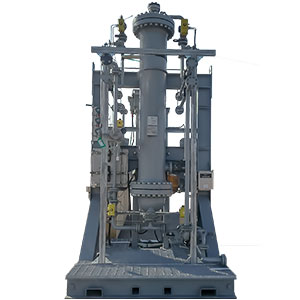Gulftronic Electrostatic Separator
General Atomics Electromagnetic Systems (GA-EMS) Gulftronic® electrostatic separators remove all FCC catalyst fines from slurry oil, providing refineries with more options to market and increase revenue from upgraded clarified oil products. With over 50 systems operating worldwide, GA-EMS has been helping customers increase revenue and reduce environmental waste for more than 35 years.
The Gulftronic Difference
GA-EMS' unique technology uses an electrostatic process to polarize, capture and remove all catalyst fines (down to the submicron level), that resist separation by conventional mechanical filtration processes. Gulftronic Electrostatic Separators are impervious to fouling by asphaltenes and coke particles. The resulting clarified oil produces feedstock for various marketable products, including carbon black, needle coke, fuel oil, and electrode pitch. The system also eliminates sedimentation of catalyst fines as hazardous sludge from refinery storage tanks, reducing settling tank waste collection and disposal.
Single- and Dual-Module Gulftronic Systems
Single-Module and Dual-Module Gulftronic® Electrostatic Separator systems support carbon black plants and other facilities with low throughput slurry oil production requirements. The Single-Module and Dual-Module Gulftronic systems allow plants to purchase lower cost feedstocks from refineries and further clarify slurry oil on-site to meet specific requirements for various carbon black products. As worldwide demand for products such as carbon black continues to grow, plants can effectively utilize Gulftronic Single and Dual-Module systems to reduce operation and maintenance costs, maximize yields, and improve profit potential. The single module system can also be used for proving theories and testing new applications prior to implementation.

